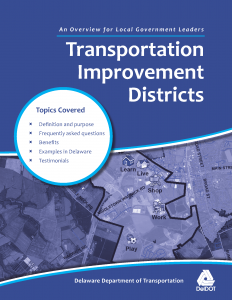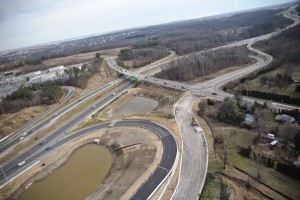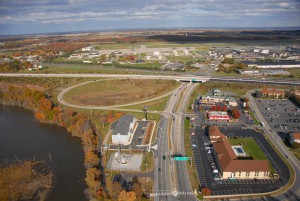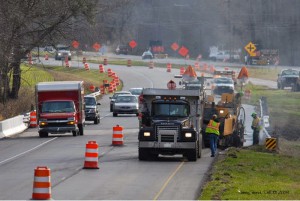Transportation, land use planning, and economic development are inextricably linked.
Transportation Improvement Districts (TIDs) can foster sustainable development and Complete Communities, a planning framework in Delaware that recognizes the impact transportation investments have on efficient land use, community form, economic development, and quality of life. Reconnecting land use and transportation can lower infrastructure costs and foster planning for market-ready (re)development opportunities. As a transportation-based impact fee, TIDs provide a way to equitably distribute the cost of development-related growth and infrastructure improvements to the private sector that benefits from the facilities.
For a brief introduction into how TIDs work in Delaware, read the Transportation Improvement Districts overview.
Planning for TIDs can strengthen partnerships among local governments, state DOTs, and metropolitan planning organizations (MPOs) to ensure that planning for future land use and transportation solutions are complementary.
This section discusses the purpose, benefits, and planning framework for creating TIDs. It also provides a step-by-step process for Delaware local governments to follow to create TID(s) and provides two best-practice examples.
This entire section is also available as a downloadable PDF guide, Transportation Improvement Districts: A Guide for Delaware Local Governments.
Topics Covered
- What is a Transportation Improvement District (TID)?
- Traditional Use of Traffic Impact Studies
- Benefits of TIDs
What is a Transportation Improvement District (TID)?
TIDs Defined
The Delaware Department of Transportation (DelDOT) defines a Transportation Improvement District (TID) in its Standards and Regulations for Subdivision Streets and State Highway Access (Standards and Regulations)* as “a geographic area defined for the purpose of securing required improvements to transportation facilities in the area.” The purpose of a TID is to comprehensively coordinate land use and transportation within a specific geographical area.
Why are TIDs Needed?
Across the nation, state transportation departments face challenges in financing infrastructure improvements. Federal funding for transportation has eroded and traditional revenue sources have failed to keep pace with capital needs of transportation improvements. Delaware is no exception. Delaware’s Transportation Trust Fund (TTF), originally designated for construction costs, became financially constrained when DelDOT’s operating budget was transferred to the TTF. Pressures to the TTF include a combination of stagnant or flat revenue streams, residual debt, rising operating and construction costs, increased transit expenses, ongoing maintenance requirements, and steadily rising demand for new projects to keep pace with economic expansion and traffic growth. Delaware’s motor fuels tax, a primary source of TTF revenue, has not been increased since 1995. Unlike other states, however, Delaware plays a key role in funding transportation and in strategic management of the state’s transportation assets. DelDOT is responsible for maintaining nearly 90% of over 13,000 lane miles in Delaware, while the nationwide average for states is approximately 20%.
Many states are eyeing or have adopted alternative funding mechanisms, including TIDs, to supplement traditional transportation revenue streams. As a transportation-based impact fee, TIDs provide a way to equitably distribute the cost of development-related growth and infrastructure improvements to the private sector that benefits from the facilities, rather than costs being absorbed by the general public. TIDs are designed to achieve fair-share mitigation of transportation impacts. They provide a funding mechanism to secure required, long-term improvements on a “fair-share” basis from developers to fund transportation infrastructure and facilities within that area.
In addition, TIDs can be an effective funding mechanism to ease land development pressures and prepare targeted growth areas for market-ready (re)development. Economic development and growth can bring jobs and additional revenue to a community. However, unintended consequences of poorly planned growth include sprawl, traffic congestion, environmental problems, and increased costs for necessary public services and infrastructure. A TID provides a framework for managing transportation impacts of planned growth. In addition, a TID can attract investment to an area targeted for growth and (re)development by expediting preconstruction phases and leveraging state and federal funds for improvements to state-owned transportation assets.
*In 2015, DelDOT expects to adopt a comprehensive rewrite of the Standards and Regulations. It is expected that there will be minimal changes to TID regulations, but the document will be renamed to “Development Coordination Manual.”
Traditional Use of Traffic Impact Studies
Development places demands on the transportation system. New development may generate enough traffic to cause congestion, safety concerns, and/or the need for infrastructure improvements—such as new signalization, turn lanes, or crosswalks. Traffic impact studies (TIS) are a common planning tool used by departments of transportation, such as DelDOT, to foresee demands on the transportation network and determine transportation improvements that may be necessary to accommodate new development. Traffic access and impact studies are also intended to maintain a satisfactory level of service and the appropriate access provisions for a proposed development.
When are Transportation Impact Studies (TIS) Required?
DelDOT’s Standards and Regulations for Subdivision Streets and State Highway Access defines a TIS as “a study conducted during the development approval process to determine the impacts that traffic generated by the proposed development will have on the surrounding street network and the improvements needed to the transportation system in order to mitigate those impacts.” In Delaware, a TIS may be required by DelDOT, a local government, or both. Although DelDOT is responsible for most of the state’s transportation network, a local government may require a TIS to determine whether a proposed development is appropriate for a site and context of land use. A TIS may be required as a condition for land use approvals to ensure that area transportation facilities operate adequately to accommodate impacts of new development.
The range of detail and complexity of a TIS may vary—depending on the type, size, and location of the development. While some Delaware jurisdictions require TIS as part of their rezoning and conditional use processes, they are most commonly, and perhaps most effectively, required as part of the subdivision and land development plan processes. Also, DelDOT and Kent and New Castle Counties have warrants for when a TIS is required.
The extent of a TIS is determined in a “scoping meeting” that includes representatives from DelDOT, the developer and, usually, the local jurisdiction. The TIS process generally includes a review of base traffic conditions, an analysis of expected trip generation, an assessment of future traffic volumes, and an analysis of site access locations and nearby intersections. A TIS scope may also consider impacts to queuing at intersections, safety, and impact on other transportation modes (e.g., bicycle, pedestrian, and public transit).
Limitations of a TIS as a Transportation Planning Tool
While a TIS is a valuable transportation planning tool, it is considered a more reactive approach for several reasons. First, a TIS focuses on the need to mitigate transportation impacts of single, new development (e.g., a subdivision) instead of providing a proactive strategy to plan for and fund long-term, area-wide transportation improvements. Second, in many cases, smaller or incremental developments, which cumulatively can have significant impacts, may not trigger the need for required transportation improvements. This may cause an unfair distribution of responsibility where the last developer in pays for all transportation improvements. Third, while a TIS estimates the number of trips generated and projects future traffic volumes, these forecasts are not necessarily incorporated into plans for future land use (e.g., comprehensive plans and master plans). Finally, the TIS approval process can be tedious and time-consuming, particularly when multiple developers are involved.
Benefits of TIDs
Transportation Improvement Districts have several benefits:
- Foster Market-Ready (Re) Development
- Support Complete Communities
- Focus Transportation Investments to High-Priority Growth Areas
- Complement Master Plans
- Support Plans for Downtown Development Districts
- Provide for “Fair Share” Contributions to Transportation Improvements
- Improve Cost-Effectiveness and Efficiency of Transportation Improvements
- Promote Intergovernmental Coordination
Foster Market-Ready (Re) Development
For Delaware to remain economically competitive, its transportation system must be able to move people and goods in a timely, efficient, and cost-effective manner. TIDs provide a systematic and comprehensive approach to funding needed transportation improvements associated with development, mitigate negative transportation-related impacts of development, improve the performance and safety of the transportation system, and direct transportation investments to planned growth areas.
Transportation improvements are critically important to attract business investment. TIDs provide transportation infrastructure necessary for market-ready (re)development and adaptive reuse of downtown districts, underutilized or declining retail centers, and aging strip malls along highway corridors. Plans developed to implement a TID can achieve acceptable levels of transportation service; accelerate development in a high-priority growth area; prioritize transportation improvements; and ensure that bicycle, pedestrian, motorist, and transit needs are addressed as development moves forward.
Support Complete Communities
Transportation investments can influence where development and economic activity occurs by providing access to land. At the same time, unmanaged land use and sprawling development patterns can drive the need for costly transportation infrastructure investment. TIDs can foster sustainable development and Complete Communities strategies by planning for transportation systems that better serve people while fostering economic vitality. Reconnecting land use and transportation can lower costs of new or expanded transportation infrastructure and facilities, which can better serve area residents, visitors, and businesses.
Focus Transportation Investments to High-Priority Growth Areas
As a transportation-related impact fee, a TID can be an effective tool for ensuring adequate infrastructure to accommodate growth where and when it is anticipated. To be effective, a TID must be based on a comprehensive plan, used in conjunction with a sound capital improvement program, and funded through a proportional fee formula. A TID can focus and coordinate transportation investments in high-priority growth areas to help support desired development patterns.
Complement Master Plans
Area-wide master plans can help to implement local-government certified comprehensive plans by spelling out the details of, and the responsibilities for, the provision of infrastructure services in an efficient, timely, and cost-effective manner. The master planning process can also help to achieve a local and regional economic vision for enhanced economic opportunities. Local jurisdictions are encouraged to develop a master plan that establishes a TID to reduce the number of required studies in a specific area. When a master plan and TID are prepared concurrently, the effects of the land use on the transportation network can be more accurately forecasted to plan for needed transportation improvements in a master-planned area.
Support Plans for Downtown Development Districts
Delaware’s Downtown Development Districts (DDD) Act is intended to leverage state resources to spur private investment in commercial business districts and surrounding neighborhoods; to improve the commercial vitality of downtowns; and to increase the number of residents from all walks of life in downtowns and surrounding neighborhoods. A TID may be considered as part of an “implementation strategy” for a DDD and share the same geographic boundaries. A TID may also be regarded as a “local incentive” for a DDD by ensuring that the transportation network can accommodate new infill, development, or redevelopment in the district.
Provide for “Fair Share” Contributions to Transportation Improvements
TIDs more fairly and equitably allocate the transportation impact of new development than individually negotiated developer agreements. TIDs provide an objective process to identify transportation improvements needed to accommodate growth, allocate fairly the costs of transportation improvements among new developments, and ensure the proper and timely accounting of improvements and funds. TIDs ensure that needed transportation infrastructure—road upgrades, interconnection of roads, and pedestrian, bicycle, and transit facilities—are constructed and that the costs of transportation improvements are not borne by the last developer. TIDs establish a fee program that is based on the premise that all new development (large and small) should pay a fair, or proportional share towards the costs of transportation improvements. TIDs that are supported through developer fair-share contributions can leverage state transportation investments and gain priority consideration during capital planning or transportation improvement planning (TIP) processes.
Improve Cost-Effectiveness and Efficiency of Transportation Improvements
The scope of the TIS is generally based on the type and intensity of a proposed land use change or development. While a TIS can assess and mitigate congestion- and traffic-related impacts of development, it can be a reactive and narrow approach. A more comprehensive and extensive analysis may be needed for large-scale developments, multiple development proposals, or multi-phased development projects in a given area. A study area that is too large may be needlessly costly and time-intensive—both to the developer and to plan reviewers. In addition, it may be difficult to ascertain whether a large, multi-phased or multiple development proposal has a demonstrable impact upon elements of the local transportation network. In these cases, creation of a TID is more proactive, cost effective, and expedient than the conducting several fragmented studies that focus on traffic-related impacts of development.
Promote Intergovernmental Coordination
Planning for TIDs can strengthen partnerships among local governments, DelDOT, and metropolitan planning organizations (MPOs) to ensure land use and transportation solutions are complementary. Because a TID can transcend the boundary of a local government (city or county), the process encourages collaboration to achieve long-term transportation solutions that could not be achieved by a single government agency or entity.
Creating a TID is consistent with a more comprehensive, regional approach to planning, programming, and coordinating land use policies, regulations, and transportation improvements. This approach will help the timing, type of, and investment in transportation improvements to accompany desired development activity.










